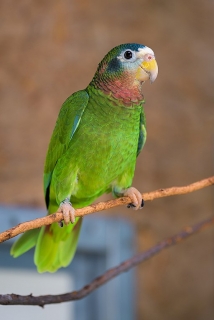Yellow-billed Amazon |
|
|
Also known as: Yellow-billed Parrot, Red-throated Amazon, Jamaican Amazon
Photos
View in GalleryDid You Know?
The Yellow-billed Amazon is one of the few Amazon parrots with a yellow bill - most other Amazons have either black or buff-coloured beaks.Programs & Projects
WPT has worked with numerous partners to help save this species. Learn moreAcademic Research
Related publications: Amazona collariaSpecies Profile
Genus: Amazona | Species: collaria
Size:
28cm (11 in)
Weight:
260g (9.1 oz)
Subspecies including nominate:
one
Colour Adult:
Both adults in general green, with yellowish underparts; black edging on feathers of crown to mantle and sides of head; white forehead and line around eyes; dull blue forecrown; pale blue lores and upper cheeks; blue/grey ear coverts tinted with green; rose/red throat, forecheeks and sides of neck; green tail with red at base. Bill yellow. Eye ring white, eye brown.
Colour Juvenile:
As in adults but with grey markings on upper mandible.
Call:
Calls made in flight bugling notes, lower in pitch than those of Black-billed Amazon and last syllable prolonged. Also high-pitched notes while perched.
Listen NowVideo Links:
Video 1More Information:
Content Sources:
CITES
BirdLife International
Cornell Lab of Ornithology/Birds of the World
A Guide to Parrots of the World, Juniper and Parr, 1998
ML Media Collection Catalogue 35357, Yellow-billed Parrot Amazona collaria, Parker, Theodore A., III, Jamaica, Mar. 1985, Cornell Lab of Ornithology. Site
Parrots: Status Survey and Conservation Plan 2000-2004, Snyder, McGowan, Gilardi and Grajal, 2000.
Parrots of the World, Forshaw and Cooper, 1977. 2010 edition
Parrots of the World, Forshaw, 2006.
Lexicon of Parrots, Thomas Arndt.
Parrots in Aviculture, Low, 1992.
Photos
View in GalleryDid You Know?
The Yellow-billed Amazon is one of the few Amazon parrots with a yellow bill - most other Amazons have either black or buff-coloured beaks.Programs & Projects
WPT has worked with numerous partners to help save this species. Learn moreAcademic Research
Related publications: Amazona collariaSpecies Care
Captive Status:
Rare
Longevity:
Probably 50+ yrs.
Housing:
Aviary or suspended enclosure, minimum length 3m (9.8 ft).
Diet:
Fruits such as: apple, pear, orange, banana, pomegranate, cactus fruits, kiwi, papaya, forming about 30 percent of the diet; vegetables such as: carrot, celery, green beans and peas in the pod; green leaves such as: Swiss chard, kale, lettuce, sowthistle, dandelion, chickweed; spray millet; small seed mix such as: canary, millet and smaller amounts of buckwheat, oats, safflower and a little hemp; limited soaked or sprouted sunflower seed; cooked beans and pulses and boiled maize, and complete kibble.
Enrichment:
Provide bird-safe, unsprayed flowering, fir, pine, willow or elder branches, different sized perches, wooden or vegetable tanned leather toys, ladders, swings, ropes and puzzle/foraging toys.
Nest Box Size:
Vertical box 10" x 10" x 24" (24.5cm x 24.5cm x 61cm).
Clutch Size:
3
Incubation Time:
26-28 days
Fledging Age:
8 weeks
Hatch Weight:
Probably 9-10g (0.3-0.35 oz).
Peak Weight:
Not recorded.
Weaning Weight:
Not recorded.
Photos
View in GalleryDid You Know?
The Yellow-billed Amazon is one of the few Amazon parrots with a yellow bill - most other Amazons have either black or buff-coloured beaks.Programs & Projects
WPT has worked with numerous partners to help save this species. Learn moreAcademic Research
Related publications: Amazona collariaSpecies Wild Status
World Population:
10,000-20,000
IUCN Red List Status:
Vulnerable
CITES Listing:
Appendix II
Threat Summary:
A BirdLife 'restricted-range' species. Threats include forest loss due to bauxite mining, forest clearance and shifting cultivation. Also affected by trapping for the pet trade and local consumption.
Range:
Jamaica, W Indies.
Habitat:
Found up to 1200m (3936 ft) in wet limestone forest with Terminalia and Cedrela sp. foliage, more arid upland forest and cultivated areas with trees at forest edge.
Wild Diet:
Forages for fruits, seeds, blossoms and leaf buds, species including Cecropia, Ficus, Annona, Citrus and Rubus. Also takes cultivated crops.
Ecology and Behaviour:
Seen in large communal roosts outside breeding season. Birds range widely during the day, returning to roost late in day. May associate with the Black-billed Amazon (Amazona agilis) and Olive-throated Conure (Eupsittula nana). Groups employ sentinels on high, exposed perches to warn flock of danger.
Clutch and Egg Size:
3 rounded eggs, 36.0 x 29.0mm (1.4 x 1.1 in).
Breeding Season:
March-May; nest is in tree cavity usually excavated by woodpeckers.
Related Links:
Photos
View in GalleryDid You Know?
The Yellow-billed Amazon is one of the few Amazon parrots with a yellow bill - most other Amazons have either black or buff-coloured beaks.Programs & Projects
WPT has worked with numerous partners to help save this species. Learn moreAcademic Research
Related publications: Amazona collariaMembers Only Resources
Please log-in now to find more research, resources and tools.
Not a Member?
Find more great information:
Gain exclusive access to 600+ pages of additional research, seminars and podcasts, specialists to ask your toughest questions, and dozens of other fun resources - when you become a WPT member.
Join Today >>

































